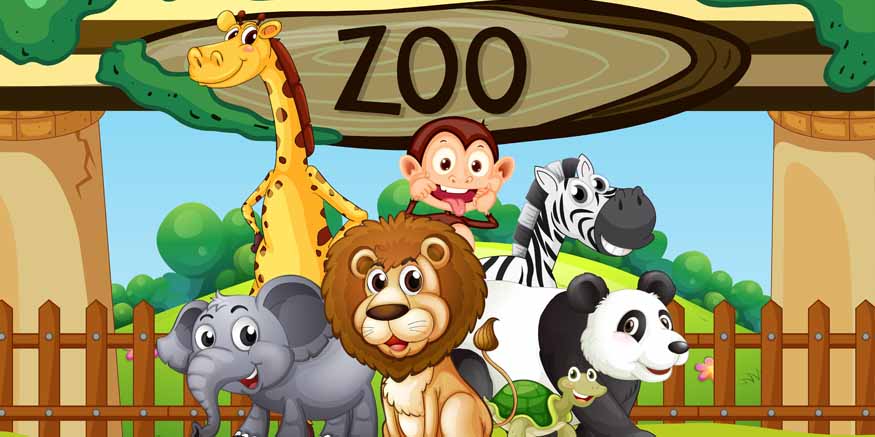Poetry is a wonderful way to introduce your young child to various common topics in a fun way! Kids tend to catch up speaking and reading new words easily in a poem. The rhyming pattern helps them remember the words and learn new concepts in a fun way. Let’s look at one such popular nursery rhyme “At the Zoo”.
What Is The Poem About?
“At the Zoo” is a nursery poem penned by the British poet, William Makepeace Thackeray. Published in 1884, it paints a whimsical and lighthearted image of the various fascinating creatures found in a zoo. The author has used simple and playful language, to create a sense of childlike wonder and excitement. The kids not only learn various animal names but can also visualise their appearance, eating habits, and common movements. The words create a visual imagery involving the senses of sight and smell as well.
Also Read: Hilarious Zoo Animal Jokes For Kids
About the Author: William Makepeace Thackeray
William Makepeace Thackeray was a well-known English poet, born on 18 July 1811 in Kolkata, India. However, he didn’t stay further in India and attended school in England from a young age. He was not fond of the formal education system and began writing poems during his school years. He mostly delved into ballads and satirical work. He was best known for his novels, The History of Henry Esmond, Esq. published in 1852 and Vanity Fair, published in 1848. His works first appeared in weekly magazines, mainly Fraser and Punch. He travelled throughout Europe and worked as a journalist in London.
“At The Zoo” Nursery Poem Lyrics
First I saw the white bear, then I saw the black;
Then I saw the camel with a hump upon his back;
Then I saw the grey wolf, with mutton in his maw;
Then I saw the wombat waddle in the straw;
Then I saw the elephant a-waving of his trunk;
Then I saw the monkeys—mercy, how unpleasantly they smelt!
“At The Zoo” Poem Summary
In ‘At the Zoo’ poem, the author, William Makepeace Thackery, playfully describes the different animals that he sees at the zoo. He first encounters a white bear and then a black bear. He further mentions seeing a camel with a hump on his back. Next, he spots a grey wolf who has mutton (the meat of sheep) in his jaws. He then mentions an endearing wombat waddling through the straw laid for it.
Amidst all these sights, he then notices an elephant playfully waving its trunk but soon his attention gets drawn to the monkeys, because of their strong stench. The author even asks for forgiveness in the last line for mentioning this.
While the author maintains a playful tone all through the poem, there are a few words that may seem too new or tough for young kids. However, the short and fun poem still manages to keep the children engrossed with the fun depiction of the various animals. The last line about the monkeys adds a surprisingly fun touch to the whole poem, initiating a good scope for laughter! At The Zoo is a quick and short poem that works great for children’s quick attention.
Difficult Words In The Poem
Maw – The jaw of an animal.
Wombat – An Australian plant-eating animal that resembles a small bear and lives in the burrows.
Waddle – To walk with short steps, like ducks.
Mercy – To Forgive (verb) or forgiveness (noun)
Smelt – A rarely used old word for ‘smelled’.
Also Read: Exploring Animal Adaptations
Tips For Teachers
- You can add a fun tune and make the kids sing along.
- Clapping at even intervals can also help add a suitable pace to this short poem.
- Kids can start moving around in a circle while clapping and singing the poem.
- Kids can be encouraged to mimic the various sounds and movements of the animals as they are mentioned.
- After the action-based singing, kids can take turns to answer fun questions about the poem and the animals mentioned to help them gain more insight.
- This poem can also be used in annual day or other school performances, where the kids get a chance to dress up and mimic the animals.
Also Read: Nehru Zoological Park in Hyderabad
Benefits Of Poems For Young Minds
- Language development
- Phonics awareness
- Listening and memorising skills
- Creativity and imagination
- Emotional expression
- Overcoming stage fear
- Group participation
- Cultural awareness
- Confidence building
- Introduction to poetry and literature
Most often kids enjoy participating in rhymes and poems, as it breaks the monotony of the regular teaching pattern. This form of fun learning also comes in handy for school annual day events or casual family performances. Short and fun poems like “At The Zoo” are a good choice to help kids learn and perform easy actions. This poem also helps kids take turns and bond over rhyming words and fun actions!
Visit EuroSchool to learn more!
Check out other Nursery Rhymes for your kids:
Wheels on the Bus
Finger Family
Two Little Dicky Birds
Merry Go Round
Hello How are You
Baby Shark
Miss Dolly Had A Polly
First Day at School
The Day of the Month
FAQs On the Poem “At The Zoo”
1. What is the theme of “At the Zoo” poem?
Ans -The poem describes the various zoo animals in a fun playful manner.
2. Who is the author of the poem “At the Zoo”?
Ans -The poem is written by William Makepeace Thackeray, a renowned British author of the 19th century,
3. Which animals are mentioned in “At the Zoo”?
Ans -The white bear, black bear, camel, grey wolf, wombat, elephant, and monkey are the animals mentioned in the order in the poem.
4. Which animal is mentioned to be waddling in the straw?
Ans- The wombat is seen waddling in the straw in this poem.
5. Which is the funniest line of the poem?
Ans- The last line about the pungent smell of the monkeys adds a humorous twist to the narrative.









